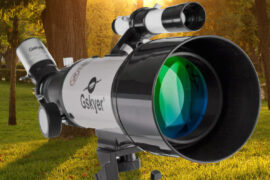What is a zoom eyepiece
A zoom eyepiece is a unique type of telescope eyepiece that has an adjustable focal length, unlike the regular ones that only have a single focal length (8mm, 16mm, 25mm, etc).
The focal length in zoom eyepieces can be adjusted simply by turning the barrel while they are still locked to your telescope. Remember the magnification of the image you see in your lens is going to depend on the focal length of the eyepiece being used.
Zoom eyepieces come in many sizes and ranges, but the most common ones are 7mm-21mm and 8mm-24mm.
What is a fixed eyepiece
A fixed eyepiece is the name we give to regular eyepieces that have a single focal length. When you buy a telescope, 99% of the time is going to include fixed eyepieces of multiple values like 10mm, 25mm, or 4mm.
Zoom Eyepieces vs Fixed Eyepieces: comparison table
| Zoom eyepiece | Fixed eyepiece | |
|---|---|---|
| versatility | High | Low |
| optical quality | Low to Mid | Low to High |
| focal lengths | Mid-range | All values |
| ease of use | High | Mid |
| recommended for beginners | Yes | Yes |
| recommended for enthusiasts | Yes | Yes |
| price | Low to Mid | Low to High |
Zoom Eyepieces Advantages
Zoom eyepieces can have many pros when compared to their fixed counterparts.
Access to many magnification options
By having adjustable focal lengths, zoom eyepieces automatically give you access to all the range of magnification values between the minimum and maximum value the zoom EP supports.
Cheaper than a collection of fixed eyepieces
While the average zoom eyepiece is more expensive than the average fixed eyepiece, when you do the math, it turns out to be cheaper to purchase a single zoom eyepiece than having multiple eyepieces to cover that same range of magnification options.
For example, to cover the same range of options than a 7mm-21mm eyepiece has, you would probably want at least 3 different fixed eyepieces: a 7mm, a 15mm, and a 20mm.
No need to switch every few minutes
When you are a begginer starting to experiment with different magnifications, you will rarely get tight the best magnification for the object you are trying to observe on your first attempt. You will need to switch between multiple eyepieces to test and learn, which can become obnoxious. Zoom eyepieces allow you to change magnification levels almost immediately with a single turn of the dial.
Higher levels of granularity to find the perfect magnification
Have you ever been in a situation when you have a 15mm eyepiece and a 18mm eyepiece and they are both just not quite right and you think “boy, I wish I had a 16.5mm eyepiece, the view would be perfect!”. Well, zoom EPs are perfect for this kind of situation.
Advantages of fixed eyepieces
But wait, don’t change all your eyepieces just yet. Zoom eyepieces seem great, but fixed eyepieces also have some things to their advantage.
Better optical quality
Fixed eyepieces beat comparable zoom eyepieces in optical quality every time.
Because of their complexity, zoom eyepieces have more lenses and mirrors inside, which always introduces optical imperfections like reflections.
Fixed eyepieces have also been optimized and quality tested specifically for their focal length, which means they will generally beat zooms on a direct comparison when using the same magnification. Beginners might not even notice these small differences, but expert stargazers looking to get the highest quality images definitely will.
You can go to the extremes
Zoom eyepieces try to be as versatile as possible, which means they generally have to stay in the mid-range of focal lengths (7mm to 24mm). When you are looking to go to the extremes of the magnification espectrum for things like planetary observation, or terrestrial viewing, only fixed eyepieces will be available. We are talking about focal lengths like 5mm, 3.6mm, 30mm, etc.
More brand and price options
There are all kinds of brand options when it comes to eyepieces. You can take your pick between the cheapest Chinese brand, and ultra-expensive high-quality options with perfect optical manufacturing that cost the same as a car’s down payment. There’s something that will fit your budget and level of expertise. Zoom eyepieces generally are only available in the mid-range of both quality and price.
Specialty options
There are eyepieces that come with advanced features such as built-in solar filters. Due to their complexity, it would not be possible to offer those features and engineer them so they can change focal lengths. These specialty eyepieces are only available as fixed.
Which one should you buy?
If you are a beginner, getting a zoom eyepiece will be the best value for your money. It will allow you to experiment and test various ranges of power so you can get to know your telescope. Combine that with the eyepieces included with your telescope and you will have a good range of options.
Check out our guide on the best zoom eyepieces to pick the one that better fits your setup.
As you progress and become a more sophisticated stargazer, you will probably still want a zoom eyepiece for the mid-range, and you will want to get individual fixed eyepieces for the extremes, and maybe even one super high quality fixed right in the middle of the range of your zoom.







